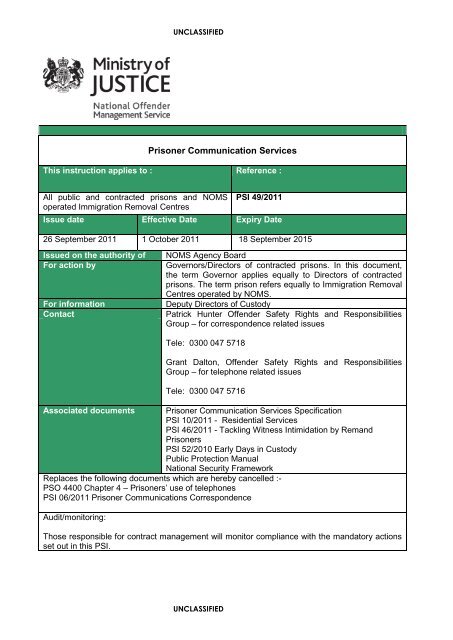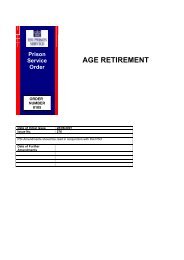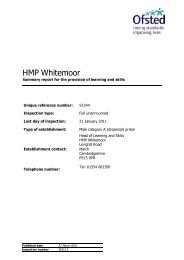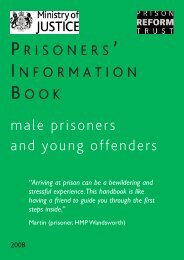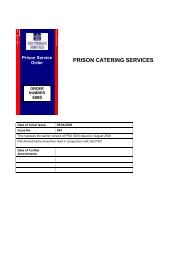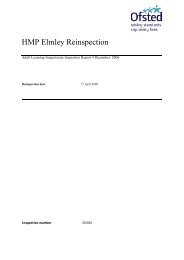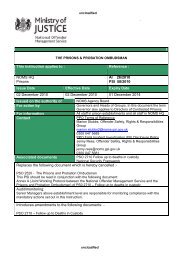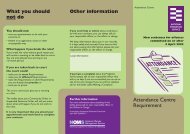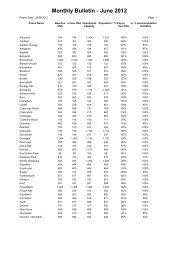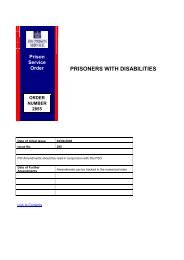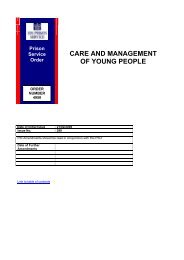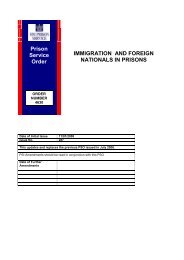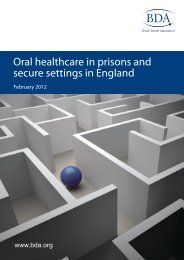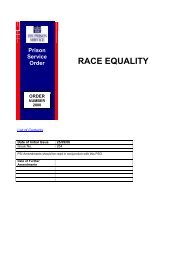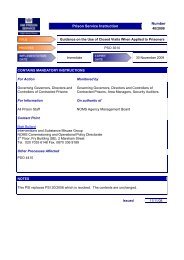PSI 2011-049 - Inside Time
PSI 2011-049 - Inside Time
PSI 2011-049 - Inside Time
Create successful ePaper yourself
Turn your PDF publications into a flip-book with our unique Google optimized e-Paper software.
UNCLASSIFIED PAGE 310. In delivering the Outputs set out in the Specification and this Instruction, staff must haveregard to equality considerations and ensure that all services are delivered fairly andappropriately, having regard to the protected characteristics defined in the Equality Act2010.Resource Impact11. This <strong>PSI</strong> does not introduce any new requirements so the financial impact should beminimal. Commissioners and Governors will recognise that whilst not mandated there maybe potential savings in some establishments through adherence to the efficient operatingmodels for these Services.Contacts12. For further information about this <strong>PSI</strong> please see contacts list on front cover.signedDigby GriffithDirector of National Operational Services, NOMS<strong>PSI</strong> 49/<strong>2011</strong> UNCLASSIFIED ISSUE DATE 26/09/<strong>2011</strong>
UNCLASSIFIED PAGE 4SERVICE ELEMENT: Prisoner Communications – GeneralOutput 1 - All prisoners are able to communicate with family, friends and professionaladvisers (Written)1.1 Prisoners are actively encouraged to maintain contact with the outside world, which wouldinclude family, friends and where applicable professional advisers/bodies.1.2 Prisoners may write to, and receive letters from, any person or organisation, subject to theacceptability of the contents and to the restrictions set out further in this <strong>PSI</strong>. Restrictionsare necessary in order to protect the public, prevent crime and ensure the security of theprison. However, this does not necessarily mean that if a prisoner corresponds with anyperson or organisation, that he/she may be visited by that person or a representative of thatorganisation.1.3 Prisoners may write letters in the language of their choice, but letters notwritten in English and which are subject to routine reading may be liable to delay whiletranslations are obtained.1.4 Prisoners can generally write as much as they wish. At establishments where routinereading of correspondence is in force, Governors may set a limit on the length of letters,subject to a minimum of four sides of A5 paper.1.5 Letters between prisoners and their legal advisers, as well as a number of statutorybodies/persons responsible for the welfare of prisoners while in custody, are treated asprivileged and must be handled in confidence (see paragraph 14.1 below for a detailed listof those to which these provision apply)..Output 2 - Minimum statutory requirements relating to the provision of letters, includingspecial letters and other communications are met (Written)Definitions2.1 Prisoners are entitled to send:(a)(b)(c)Statutory Letters (free to the prisoner/paid for from public funds) - one that aprisoner is entitled to under Prison Rule 35 or Young Offender Institution Rule 10, andmust not be withdrawn or withheld as part of a punishment.Privilege Letter (paid for by the prisoner) - one that a prisoner is regularly allowed tosend over and above their statutory entitlement of letters.Special Letter (in exceptional circumstances) - one that is not counted against aprisoner‟s allocation of statutory or privilege letters and which he/she is givenpermission to send for some special reason (see paragraphs Special Letters below).The postage costs of some but not all of these will be paid for out of public funds.Allowances2.2 Unconvicted prisoners and those held under an Immigration Detention Warrant (see list ofdefinitions contained in Annex A of PSO 4600 – Unconvicted, Unsentenced and CivilPrisoners) may send:(a)(b)two Statutory Letters per week;as many Privilege Letters as they wish;<strong>PSI</strong> 49/<strong>2011</strong> UNCLASSIFIED ISSUE DATE 26/09/<strong>2011</strong>
UNCLASSIFIED PAGE 72.15 Letters sent at public expense must be sent first class or by air mail if:(a)(b)(c)they are Special Letters sent on transfer;they are in connection with an appeal;exceptionally, postage at the higher rate has been approved by the Governor.2.16 The correspondents of some prisoners may wish to send them stamped addressedenvelopes, bearing their return address, to encourage them to write letters and to help with thecosts. This must be allowed and no deductions must be made from the private cashallowance for the cost of the stamps or envelopes received.2.17 Additionally, correspondents may send in monies to prisoners in the form of cheques or postalorders which will be credited to their private cash account and should be managed inaccordance with the guidance covered in PSO 4465 Prisoners Personal Financial Affairs.Correspondents2.18 A prisoner may write to, and receive letters from, any person or organisation, subject to theacceptability of the contents and to the restrictions set out further in this <strong>PSI</strong>. However, itdoes not necessarily follow that because a prisoner is in correspondence with a person ororganisation that he/she may be visited by that person or a representative of thatorganisation.2.19 If the recipient of correspondence from a prisoner requests in writing to the prison that nofurther letters should be sent, the prisoner must be informed of the request, asked to cooperateby not writing and given the opportunity to discuss the matter with a member ofstaff. If the prisoner then hands in a further letter for posting, the prison must comply withthe recipient's request and inform the prisoner that the letter and any subsequent letters tothe intended recipient will not be sent. The letter will then be returned to the prisoner.Correspondence with children (defined as someone under 18 years of age)2.20 If a prisoner wishes to correspond with a child, the procedures set out above in paragraph2.19 will be applied if the person or authority having parental responsibility for the care ofthe child requests that the correspondence between them is stopped.2.21 Prisoners identified as presenting a risk to children are managed under SafeguardingChildren procedures and any contact with a child must comply with the Child Contactprocedures contained within Chapter 2 of the Public Protection Manual. This means thatany prisoner falling under this category must first apply to a member of staff in order tocorrespond with a child. Where these safeguarding procedures apply contact with childrenwill only include contact with the prisoner‟s immediate family or children, and the children ofa partner provided they were living together as partners in an enduring family relationshipprior to imprisonment. Included within this definition are sons and daughters, brothers andsisters, grandchildren, stepchildren, adopted children and foster children. A prisoner maybe permitted contact with other children provided the prisoner can produce a substantialcase for contact and the Governor agrees that such contact would be in the interests of thechild and only after a full risk assessment had been carried outCorrespondence with young prisoners2.22 If the Governor considers that correspondence between a prisoner who is under 18 andany other person would not be in that prisoner‟s best interests, they may stop thecorrespondence, taking into account the views of the prisoner‟s parent or guardian. If the<strong>PSI</strong> 49/<strong>2011</strong> UNCLASSIFIED ISSUE DATE 26/09/<strong>2011</strong>
UNCLASSIFIED PAGE 8Governor proposes to exercise this discretion in relation to correspondence with a closerelative this should be done in accordance with procedures in the Local Security Strategy.2.23 A close relative is defined as a spouse/partner (including a person - whether of the same ordifferent sex - with whom the prisoner was living as a couple in an established relationshipimmediately prior to imprisonment) parent, child, brother, sister (including half or stepbrothersand sisters), grandparent, civil partner, fiancé or fiancée, or a person who hasbeen acting in loco parentis to a prisoner, or a person to whom the prisoner has been inloco parentis i.e. where they have had/have parental responsibility for that person. Thosewho have clearly demonstrated the intention to register a civil partnership with the prisonerbut have not yet done so may also be included within this definition of close relative for thepurposes of correspondence.Inter-prison and ex-prisoner mail2.24 Correspondence between convicted prisoners requires the approval of the Governors ofboth the prisons concerned, except where the prisoners are close relatives (as definedabove) or where they were co-defendants at their trial and the correspondence relates totheir conviction or sentence. Subject to the provisions above, approval should be givenunless there are reasons to believe that such correspondence will seriously impede therehabilitation of either prisoner, or where it would be desirable, in the interests of security orgood order and discipline, that the prisoners should be prevented from communicating.Accordingly, if the Governor of the sending establishment has no objections, the lettershould be sent to the Governor of the recipient's establishment with a covering note invitingthem to consider whether it should be issued.2.25 Correspondence with ex-prisoners should be allowed, subject to any concerns there maybe regarding threats to security (see below) and, if the ex-prisoner is under supervision inthe community, to the views of his/her supervising offender manager, unless the Governorbelieves that it would seriously impede the rehabilitation of either.Victims and public protection issues2.26 Prisoners wishing to correspond with the victim of their offences, or the victim’s family, mustfirst apply to the Governor for permission to do so, which may be withheld if it is consideredthat the approach would add unduly to the victim’s or family’s distress. The Governor mustcontact any probation victim liaison officers involved with the victim or victim’s family, andtake into account any concerns they raise about any such contact. Further information canbe found in the Public Protection Manual in relation to protection from harassment as wellas the National Security Framework. This restriction is in line with Prison Rule 34 (2) & (3)and is compliant with Articles 8 & 10 of the ECHR. This restriction does not apply where:(a)(b)(c)the victim is a close relative (as defined above) and who wishes to receive correspondence;the victim has already written to the prisoner since conviction and/or they are in contact forthe purposes of mediation or restorative justice;the prisoner concerned is unconvicted, unless there is evidence that they may be harassingthe victim, thereby breaking any conditions imposed by the Courts, or attempting to pervertthe course of justice.Threats to security2.27 The Governor has the discretion to disallow any correspondence with a person ororganisation if there is reason to believe that the person or organisation concerned isplanning or engaged in activities which present a genuine threat to security or good order ofthe establishment or other prisons. This is covered under Prison Rule 34 (2) & (3) and<strong>PSI</strong> 49/<strong>2011</strong> UNCLASSIFIED ISSUE DATE 26/09/<strong>2011</strong>
UNCLASSIFIED PAGE 116.2 If the prisoner is subject to, or likely to be subject to, public protection restrictions (includingan identified risk of intimidating victims or witnesses), or is provisional Category A/CategoryA prisoner, a member of staff should make the call on the prisoner’s behalf, checking thatthe recipient is willing to receive the call in the first instance.6.3 Where a prisoner is making the call a personal identification number or PIN will be requiredand the account credited with funds before a call can be made. A call made on reception orin the first night accommodation can be funded in two ways or a combination of both:(a)(b)by the use of one generic PIN account, pre-funded with credits which are paid forfrom public funds to enable them to make a short call;after signing the Communications Compact, the prisoner is put on the PINphonesystem with their own personal account and PIN credits are issued as an advance.6.4 With both options the call will be recorded. If a prisoner wishes to make a legal call theonus will be placed on the prisoner to inform staff that they wish to make such a call. Onreception calls to legal advisers must not be made via a PINphone until a prisoner’sPINphone account has been properly set up. A member of staff must first ring the numberprovided by the prisoner to verify that the number is a bone fide legal number.Communications Compact6.5 Copies of the communication compact are available on the National Security Framework(NSF).6.6 Wherever possible, prisoners must agree and sign a copy of the Communications Compactbefore making their first call. Failing this the Compact must be signed before the prisoner isissued with their own personal PIN number. The Compact must be explained to allprisoners and if a prisoner has reading difficulties the Compact must be read to them andsigned by the member of staff. The prisoner should also sign that this action has beenundertaken to evidence that they were present when the Compact was explained to them.6.7 Prisoners will be required to differentiate between social numbers to be placed on the“open” side of the PINphone system and legal and confidential access numbers on the“restricted” side on the Compact. It remains the responsibility of the prisoner to distinguishbetween social and legal/confidential access numbers in the first instance and the Compactmay be used for evidential purposes to this effect.6.8 Once signed the document should be stored in such a way to ensure that it is readilyaccessible. This document could be stored with the prisoners‟ core record or security filealthough a consistent approach to storage across the establishment is recommended.6.9 Where the Person Escort Record and the police/CPS MG6 form identifies the need forspecific restrictions to be placed on the prisoner’s communications the prisoner must bereminded that they must not seek to contact those named persons either by telephone orletter.General access6.10 Prisoners must be given access to the PINphone during association and at other suchtimes as are reasonably practicable, depending on the nature of the establishment'sregime. The time available for using the phones must not normally be less than two hourseach day.<strong>PSI</strong> 49/<strong>2011</strong> UNCLASSIFIED ISSUE DATE 26/09/<strong>2011</strong>
UNCLASSIFIED PAGE 126.11 Phones can be scheduled to come on and off according to the prison's working day.Different schedules can be applied to different days, or the phones can be left switched onall the time. These schedules are applied centrally within the establishment.6.12 Any prisoner on a call enabling regime will be required to have the numbers approvedbefore the call can be made to that number. All legal and confidential numbers provided byprisoners should be checked and verified as bone fide. The checking of social numbersmust be proportionate to risk and checked as necessary in accordance with the NSF andas set out in the local security strategy.6.13 Prisoners on a call enabling regime will be allowed up to:(a)(b)20 social numbers;15 legal and confidential access numbers. If engaged in litigation prisoners may bepermitted a second account of a further 15 legal numbers. Under exceptionalcircumstances, Governors will have discretion to allow a prisoner more than 30 legalnumbers.6.14 In addition to their personal lists prisoners will also be able to access local (establishmentbased) numbers and global (estate wide) numbers (e.g. Samaritans, Crimestoppers).Telephone numbers for the courts in England and Wales are available to all prisoners. Acentral number for the Palace of Westminster is also contained in this list. Prisoners canring this number and then be connected to the Member of Parliament‟s office of theirchoice. Establishments must add their local Samaritans branch contact number to localallowed lists.6.15 All prisoners subject to call enabling will only have access to telephone numbers on theirpersonal lists that have been approved by their current establishment. A transfer from oneprison to another does not require the receiving prison to automatically accept thetelephone numbers on the prisoners allowed list.6.16 Governors must not permit the insertion of any numbers submitted by a prisoner if theyhave any reason to believe that the number is one submitted on another prisoner's behalf,or if the prisoner cannot justify his/her need to contact the number in question. If there isany doubt, prisoners must be asked to produce further verification for any number they wishto have on their list, e.g. a Ietter or authorisation from the recipient that they are content toreceive calls from the prisoner.6.17 Should a prisoner wish to amend his personal list s/he must not be charged for adding to ordeleting legal numbers from their PINphone account. If a prisoner loses their PIN numberor allows it to become compromised the Governor may charge for the issuing of a new PINnumber.6.18 Prisoners are permitted to telephone business numbers but for the sole purpose ofspeaking to family and friends.6.19 Prisoners are not permitted to make any commercial enquiries or order goods using thetelephone. Prisoners are not able to make calls to or via the operator, to other operatorservices and must not be given access to telephone directories. Should a prisoner need toknow a particular number or an area code they must make an application to an OperationalManager, explaining why they want to call the person in question. Staff must look thenumber up on the prisoner’s behalf.<strong>PSI</strong> 49/<strong>2011</strong> UNCLASSIFIED ISSUE DATE 26/09/<strong>2011</strong>
UNCLASSIFIED PAGE 13Inter-Prison telephone calls6.20 Where prisoners who are either close relatives or partners are detained in different prisons,in order to facilitate regular contact by telephone, the establishments concerned must agreebetween them that one prisoner may be permitted to receive a call on an official telephoneat a time convenient to both prisons. Where appropriate once the number has been addedto the prisoners PIN account the outgoing call should be made using a PINphone. The callwill be recorded at the originating establishment, thus meeting any security considerations.The ability to make such calls and the subsequent frequency of any further inter-prisontelephone calls will be at the discretion of an Operational Manager.Additional guidance6.21 Annex A contains guidance about the ways in which the PINphone system can beconfigured in order to restrict prisoner use and arrangements for discharge. Annex Bcontains some guidance for particular groups of prisoners.Output 7 - Incoming phone calls from official bodies or the courts can be facilitated(Speech)7.1 The PINphone system does not accept incoming calls. Any arrangement to allow incomingcalls must involve an official telephone. Prisoners will continue to receive pre arrangedcalls on office phones from members of staff of the Prison and Probation Ombudsman'sOffice and the Criminal Cases Review Commission.Output 8 - Prisoners can make urgent phone calls for domestic or legal reasons at publicexpense (Speech)8.1 Where there are urgent legal or compassionate circumstances, such as imminent courtproceedings or a domestic crisis, Operational Managers have discretion to allow such callsto take place at public expense. Before agreeing to such an application, OperationalManagers must satisfy themselves that the need could not adequately be met by means ofa visit or letter. The Operational Manager must also be satisfied that the prisoner hasinsufficient credit within their PINphone account to make the call.8.2 The costs of these calls must be at public expense. Such calls can be made either via anofficial telephone or a generic PINphone account, pre-funded with credits paid for withpublic funds.Output 9 - Prisoners with close family abroad who have not had a social visit in thepreceding month will be helped to maintain family ties and outside contacts by provision ofa free five minute phone call (Speech)9.1 Foreign national prisoners or those with close family abroad must be permitted a free fiveminute call once a month where the prisoner has had no social visits during the precedingmonth.9.2 Consideration must be given to allowing such prisoners to have access to telephonesoutside normal hours to make calls to their country of origin where there is a significant timedifference between their country of origin and the UK.Output 10 - Prisoners may communicate with members of the media (General)10.1 Staff must refer to <strong>PSI</strong> 37/2010 Prisoners Access to the Media for further guidance onprisoners having legitimate access to the media.<strong>PSI</strong> 49/<strong>2011</strong> UNCLASSIFIED ISSUE DATE 26/09/<strong>2011</strong>
UNCLASSIFIED PAGE 14Output 11 Prisoners are prevented from sending and receiving illicit or unauthorisedarticles, information or data (General/Written/Speech)11.1 Letter paper and air letter forms should be stamped at the head with the name and addressof the establishment before issue. However, Governors may allow a prisoner to write onplain paper which does not indicate its place of origin to his or her child or, at theGovernor‟s discretion, to any other person or organisation, and greetings cards with only asimple greeting need not show the address of the establishment.11.2 The private postal address of the establishment must be on the outside of air letter forms.Restrictions on correspondence – including publication on the Internet11.3 Correspondence may not contain the following:(a)Material which is intended to cause distress or anxiety to the recipient or any otherperson, such as:(i) messages which are indecent or grossly offensive;(ii) a threat;(iii) information which is known or believed to be false;(b)(c)(d)(e)(f)(g)(h)(i)(j)Plans or material which could assist or encourage any disciplinary or criminaloffence (including attempts to defeat the ends of justice by suggesting thefabrication or suppression of evidence);Escape plans, or material which if allowed would jeopardise the security of a prisonestablishment;Material which would jeopardise national security;Descriptions of the making or use of any weapon, explosive, poison or otherdestructive device;Obscure or coded messages which are not readily intelligible or decipherable;Material which is indecent and obscene under Section 85(3) of the Postal ServicesAct 2000;Material which, if sent to, or received from, a child might place his or her welfare atrisk;Material which would create a threat or risk of violence or physical harm to anyperson, including incitement to racial hatred;In addition to restrictions on access to the media (see <strong>PSI</strong> 37/2010 Prisoners‟Access to the Media), material which is intended for publication or use by radio,television or the Internet (or which, if sent, would be likely to be published orbroadcast on these media channels) if it:(i)is for publication in return for payment, unless the prisoner is unconvicted.However, prisoners are permitted to receive payment for pieces of artwork orwork of literary merit but only if they do not contravene any of the restrictionscontained within paragraphs (ii)– (v) below and only if channelled throughappropriate charitable organisations. This should not be done on a regular<strong>PSI</strong> 49/<strong>2011</strong> UNCLASSIFIED ISSUE DATE 26/09/<strong>2011</strong>
UNCLASSIFIED PAGE 15basis so as to constitute any form of business activity (i.e. beingcommissioned to write a series of books or a regular feature in a nationalpublication). It would be for the Governor to decide if such materialcontravened any of these restrictions. Further guidance on this is atparagraph 2.27 of PSO 4465 - Prisoners‟ Personal Financial Affairs;(ii)(iii)(iv)(v)is likely to appear in a publication associated with a person or organisation towhich the prisoner may not write as a result of the restriction oncorrespondence in paragraph 2.26 above;is about the prisoner's own crime or past offences or those of others, exceptwhere it consists of serious representations about conviction or sentence orforms part of serious comment about crime, the criminal justice system orthe penal system;refers to individual prisoners or members of staff in such a way that theymight be identified;contravenes any of the restrictions on content applying to letters;(k)(l)In the case of a prisoner against whom a deportation order is in force, materialconstituting or arranging any financial transaction unless the Governor is satisfiedthat there is a genuine need for such a transaction (i.e. if in relation to the financialsupport of a close relative or if seeking advice in order to petition againstdeportation). This restriction does not apply to a prisoner whose sentence includesa recommendation for deportation but where a decision has not been made by theSecretary of State to act upon the recommendation;In the case of a prisoner in respect of whom a receiving order or confiscation orderhas been made or who is an undischarged bankrupt, material constituting orarranging any financial transaction except:(i)(ii)(iii)(iv)(v)on the advice of the Official Receiver;to pay wholly or in part a fine or debt in order to secure the prisoner's earlierrelease;to defend criminal proceedings brought against the prisoner;to meet the cost of communicating with or instructing a solicitor to act on theprisoner's behalf in bankruptcy proceedings;to meet the costs of the prisoner's production in bankruptcy proceedings.11.4 A prisoner may not ask, in writing or otherwise, another person either inside or outside theestablishment they are held in, to make on his or her behalf a communication which he orshe would not be allowed to make direct, or which would contravene the restrictions inparagraph 11.3 or any other part of this Prison Service Instruction.11.5 On induction, prisoners at Open, Category C, Category B training establishments, femaleand young offender establishments must be informed that their correspondence will notnormally be read. However, in each case it must be made clear to the prisoner that theyare still required to observe the restrictions contained within this order, and that if they fail todo so, the Governor may order all their correspondence to be read or take appropriatedisciplinary action.11.6 Any incoming correspondence or parcel, which is recorded/signed for or<strong>PSI</strong> 49/<strong>2011</strong> UNCLASSIFIED ISSUE DATE 26/09/<strong>2011</strong>
UNCLASSIFIED PAGE 16special delivery must be signed for by staff at the gate as confirmation that the item hasactually been delivered to the prison by Royal Mail. Any parcel would also need to beprocessed in accordance with the guidance found at paragraphs 2.64 -2.66 of <strong>PSI</strong> 12/<strong>2011</strong>– Prisoners‟ Property. Unless covered by the arrangements for Rule 39 or ConfidentialAccess mail, it must then be opened and examined in the normal way for any illicitenclosures and passed to the prisoner concerned as soon as is possible. In order toprevent complaints that a valuable item has been lost, it must be opened in the presence ofanother member of staff. A record must be kept of the receipt of all parcels and recordedsigned for/special delivery letters and any prisoner who requests the original Royal Mailreceipt should be given this to keep.11.7 Prisoners must not communicate by telephone matters that they would not be allowed tocommunicate by letter under the terms of paragraphs 11.3 to 11.4 aboveOutput 12 - Prisoner communications are facilitated in a manner which ensures:Maintenance of securityThe safeguarding of ChildrenPublic Protection12.1 Should staff hear a call, either through monitoring or by chance overhearing, whichbreaches the conditions of use set out in the Compact, the call must be ended and thematter reported to an Operational Manager. The system can be used to terminate the call.12.2 Where there is evidence of a possible criminal offence, the matter must be referred to theSecurity Department for consideration of a referral to the police for investigation. Where aprisoner is subsequently found to have abused the telephone system, he or she should becharged with an offence under Prison Rule 51, paragraph 23 YOI Rule 55, paragraph 25.12.3 The signed communications Compact may be produced in evidence at any subsequentadjudication. Governors may, in addition, as a separate administrative measure, prohibitthe prisoner from using the PINphone for a period to prevent further abuse.12.4 Where a prisoner who is assessed as posing a risk to children wishes contact with aspecific child, staff must refer to Safeguarding Children: Child Contact protocols in Chapter2 of the Public Protection Manual.12.5 If the person or authority with parental responsibility for the care of a child (i.e. a personunder 18 years of age) requests in writing that telephone calls from a prisoner to that childcease, the prisoner's phone account must be amended to prevent the prisoner fromtelephoning the child. Where the number is removed the prisoner should be informedaccordingly. Additionally, if an Operational Manager considers that telephone calls from ayoung person in his or her custody to any person are not in that young person’s bestinterests the phone account can be amended to prevent the telephone calls to thatindividual. The Operational Manager must take account of any views that the youngperson's parent or guardian may express. Again where this occurs the prisoner should beinformed accordingly.12.6 Prison staff must be familiar with the procedures and restrictions that may apply toprisoners convicted of, or remanded in custody for, harassment offences, or are subject toa restraining or injunction orders. Detailed guidance is contained within Chapter 6 of thePublic Protection Manual.12.7 Safeguards must be in place to ensure that unconvicted prisoners cannot make contactwith victims and witnesses. Further guidance can be found within <strong>PSI</strong> 46/<strong>2011</strong>TacklingWitness Intimidation by Remand Prisoners. Where, despite best efforts to prevent this,<strong>PSI</strong> 49/<strong>2011</strong> UNCLASSIFIED ISSUE DATE 26/09/<strong>2011</strong>
UNCLASSIFIED PAGE 17contact has been made the matter should be drawn to the attention of the police as amatter of urgency.12.8 Prisoners will only be allowed to telephone victims of their offences in the followingcircumstances:(a he or she is a close relative, as defined in paragraph 2.23;(b)(c)the victim has first approached the prisoner;the Governor considers that the call would not cause undue distress to the victim.12.9 Requests by the victims of harassment offences where there is a court order or injunctionpreventing contact should ordinarily be refused on the grounds that approval would not onlyput the service at odds with the Courts if restraining orders or injunctions are in force, butcould also jeopardise the safety of themselves and others. Should the victim continue toexpress a wish to have telephone contact with the offender, the victim should be advised bymembers of staff that they or their legal advisors should approach the Courts for a varianceof the court order. It is the responsibility of the victim and not the establishment to makethis approach.12.10 If a member of the public requests in writing that a prisoner should not be allowed tocontact him or her, the prisoner’s phone account must be amended to barthe prisoner from telephoning the individual.. Where the number has been removed theprisoner should be informed. Consideration should be given to locally bar the number toprevent other prisoners from adding it to their PIN account on behalf of the prisoner.Access to the Internet and social networking sites12.11 Prisoners must not be permitted to access or contribute via a third party to any socialnetworking site while in custody. The restrictions on correspondence equally apply tocommunication while on temporary release from custody and, where appropriate, licencesmust reflect this. Prisoners do not have access to the Internet other than for educational orresettlement purposes (and only then under strict supervision) but some prisoners havemanaged to gain unauthorised access to social networking sites to update their profiles.This has been done by using illicit mobile phones, via a third party – e.g. a letter to a friendis posted on their Facebook profile, or accessing the Internet while on release on temporarylicence. There are instances when prisoners have legitimate reasons to access the Internetwhen on temporary licence (this may be in cases where a prisoner is undertaking a periodof work experience with an employer who may use the Internet as a legitimate part of theirbusiness) but this must never involve contact with people to whom they present a risk ofharm or with victims of their offence.12.12 Concerns about a prisoner accessing or up-dating an active profile on Facebook should bereported to the security manager to consider what action to take. If it is believed that anillicit mobile telephone is being used, every effort should be made to recover it. It a prisoneris passing material by post his mail should be monitored. Where a prison can identify anaccount connected to a serving prisoner, and there are risks to victims or witnesses, thematter should be referred to Patrick Hunter (Patrick.Hunter@noms.gsi.gov.uk) in OffenderSafety, Rights & Responsibilities (OSRR). Only OSRR has authority to liaise with socialnetworking sites and to seek the removal of unauthorised sites.<strong>PSI</strong> 49/<strong>2011</strong> UNCLASSIFIED ISSUE DATE 26/09/<strong>2011</strong>
UNCLASSIFIED PAGE 18Output 13 - Prisoners are aware that their spoken and written communications may bemonitored (other than legal or confidential access calls).13.1 When first received into prison all prisoners must be informed that their telephone andpostal communications may be monitored and that calls will be recorded. This must bedone both verbally and, in order to avoid any element of doubt, within the prisoner‟sinduction programme or induction pack documentation.13.2 In signing the Communications Compact and accepting the terms and conditions ofPINphone use prisoners will be aware that, with the exception of legally privilegedconversations and calls made to confidential access organisations, all calls will be recordedand may be monitored by prison staff. Any monitoring activity should be in accordance withthe instructions contained within Function 4 of the National Security Framework and theestablishment‟s Local Security Strategy.13.3 A notice must also be displayed above/adjacent to all wing PINphones with similarinformation regarding the monitoring of their calls. Where appropriate it remains theresponsibility of the prisoner to inform the person who s/he is calling that both sides of theconversations are being recorded. An example is at Annex C.Output 14 - Confidentiality of legally privileged or confidential access communications ismaintained (Privileged Communications).Legal and confidential mail14.1 Correspondence between prisoners and the organisations/individuals listed below aresubject to confidential handling arrangements as follows:a) RULE 39The prisoner‟s Legal Adviser (which may just be the name of a firm or organisationsuch as Prisoners‟ Advice Service where the prisoner does not know name of legaladviser)CourtsBar CouncilLaw SocietyOfficial Solicitorb) CONFIDENTIAL ACCESSCriminal Cases Review Commission (CCRC)Legal Ombudsman (solicitors) or the Bar Standards Board (barristers)Care Quality CommissionParliamentary & Health Service OmbudsmanOffice of the Legal Services OmbudsmanPrisons and Probation Ombudsman (PPO)Her Majesty‟s Inspectorate of Prisons (HMIP)Members of the National Council of Independent Monitoring Boards (IMB) and itsSecretariatEquality and Human Rights Commission (EHRC)Members of Parliament (MP) or Members of the National Assembly for Wales (AM)or Members of European Parliament (MEP)Embassy or Consular OfficialsSamaritansRegistered Medical Practitioners (but only in cases where they are treating aprisoner with a life threatening medical condition)<strong>PSI</strong> 49/<strong>2011</strong> UNCLASSIFIED ISSUE DATE 26/09/<strong>2011</strong>
UNCLASSIFIED PAGE 19An Electoral Registration Officer (for submitting a postal vote only)14.2 Prison Rules 38 and 39 (1) and Young Offender Institution Rules 16 and 17 (1) provide forcorrespondence between prisoners and their legal advisers (defined as solicitor, counsel, ora clerk acting on behalf of either) or the Courts to be treated as privileged. This includeslegally privileged material handed over on visits. For outgoing correspondence, letters maybe addressed just to a firm of solicitors or organisation like the Prisoners‟ Advice Servicewhere prisoners are unsure of the legal adviser‟s name. The following points must befollowed by all staff to prevent incorrect interference with incoming legally privilegedcorrespondence:(a)(b)Legally privileged correspondence must not be stopped, opened and/or read, except inspecific circumstances outlined in the Prison Rules;Legally privileged correspondence must only be opened if the Governor has reasonablecause to believe that;(i)(ii)it contains an illicit enclosure;the letter is not from a recognised legal adviser or other body covered byRule 39. This decision must be made on a case by case basis by thegovernor and recorded on the prisoner correspondence log;(c)If the letter is opened due to a reasonable suspicion that it is not from a legal adviser orcourt, the following procedures apply:(i) If on initial examination, the letter is from a legal adviser or another Rule 39body, the letter must not be read but must be placed back in the envelopeand passed to the prisoner. A Security Information Report (SIR) should besubmitted and a letter sent to the legal adviser concerned noting what hadhappened;(ii)If, on initial examination, the letter is not from a legal adviser or other Rule39 body, the letter may be read. A SIR must be submitted and considerationgiven to further communications monitoring;(d)(e)(f)(g)Legally privileged correspondence must only be stopped, opened and/or read if thegovernor has reasonable cause to believe its contents endanger prison security or thesafety of others or are otherwise of a criminal nature;Any legally privileged correspondence opened on the basis of 14.2 (b) and 14.2(d) abovemust only be opened in the presence of the prisoner concerned (unless he or she declinesthe opportunity) and the prisoner must be informed if such correspondence is to be read orstopped;In exceptional cases, Prison Rule 35A (2A) allows for an application to be made to theChief Executive Officer of the National Offender Management Service; the Directorresponsible for National Operational Services or the duty Director of NOMS for plannedinterception of communications between a prisoner and his/her legal adviser.Communications in this context includes mail and telephone calls. The only grounds forauthorising ongoing interception would be a reasonable belief that the communication wasbeing made with the intention of furthering a criminal purpose. Any such application mustfirst be discussed with a Manager in the National Intelligence Unit on 0300 047 6354;A comprehensive guide on how to handle both Rule 39 and Confidential Accesscorrespondence is at Annex D. <strong>PSI</strong> 49/2010 (insert link) provides guidance aboutsearching legal correspondence during a cell search.<strong>PSI</strong> 49/<strong>2011</strong> UNCLASSIFIED ISSUE DATE 26/09/<strong>2011</strong>
UNCLASSIFIED PAGE 2014.3 Correspondence between prisoners and their legal advisers and/or courts must be handledin accordance with the guidance contained in Annex D. The envelopes of legalcorrespondence should be clearly marked ‘Prison Rule 39’ or in the case of YOIs andJuveniles ‘YOI Rule 17’ or ‘legal correspondence’.14.4 „Confidential Access‟ correspondence is not covered by the Prison or YOI Rules but isentitled to the same privileged handling arrangements as legal mail and applies tocorrespondence with certain statutory bodies and individuals (a full list is in paragraph 14.1above). The same handling arrangements apply to Confidential Access correspondence,except that the envelope should be marked „Confidential Access‟ (as opposed to Rule 39)and should be clearly addressed to one of the qualifying bodies. Similarly all incoming mailfrom these bodies and individuals should bear the appropriate identifying mark that iscommonly associated with that particular organisation. In some circumstances it may beappropriate for outgoing letters addressed to these organisations to be recorded in aCommunications Log.14.5 If by oversight an outgoing letter does not bear the correct marking but is clearly addressedto an individual or organisation covered by paragraphs 14.2 & 14.3, it must continue to betreated as privileged and handled in accordance with the guidance contained in Annex A.If incoming correspondence does not carry the proper marking which identifies it asoriginating from one of the bodies listed in paragraph 14.1 it should also be handled inaccordance to the guidance in Annex D.14.6 It should be noted that only correspondence between a prisoner and their legal adviser orthe courts is designated as Rule 39. Correspondence to other legal bodies generally fallsunder confidential access, but there may be instances where the content means thatdocuments to other bodies would be counted as Rule 39 (e.g. copies of documentsbetween a prisoner and his/her solicitor which are referred to the OSS, Bar Council or LawSociety).Members of Parliament (MP), Members of the European Parliament (MEP) or Members of theNational Assembly for Wales (AM)14.7 Correspondence between prisoners and their MP, AM and MEP must be treated as privilegedbut only where they are acting in a constituency capacity (not in a social capacity). Thisprivilege does not extend to Members of the House of Lords, who have no constituencyresponsibilities, or to Local Councillors. All outgoing correspondence must be appropriatelyaddressed i.e. to the particular Member at (i) the House of Commons, (ii) the NationalAssembly for Wales and (iii) the European Parliament and should also bear the prisoner’shome or current (prison) address. All incoming correspondence should be written on andenclosed in officially recognised stationery and displaying an official identifying mark of theappropriate authority. However, if an MP, AM or MEP is writing to a prisoner in a purely socialcapacity, i.e. that individual is a personal friend or colleague, then the letter is not covered bythis privilege and official stationery should not be used.Embassy or Consular Officials (Also see <strong>PSI</strong> 22/2007 - Communications with Embassies andPSO 4630 - Immigration and Foreign Nationals in Prison)14.8 The Vienna Convention on Consular Relations, which has been supplemented by a number ofbilateral agreements between the United Kingdom and other countries, guarantees freedom ofcommunication between Consular officers and their nationals. This applies to foreignnationals held in UK prisons.14.9 On reception into prison, all foreign national prisoners should be informed of their right tocommunicate with the appropriate consular office or High Commission and an extra letter sentat public expense should be allowed if a prisoner wishes to notify either of their imprisonment.<strong>PSI</strong> 49/<strong>2011</strong> UNCLASSIFIED ISSUE DATE 26/09/<strong>2011</strong>
UNCLASSIFIED PAGE 2114.10 However, the above paragraphs do not apply to a prisoner who is seeking asylum in theUnited Kingdom or who is detained under the Immigration Act 1971 and is makingrepresentations against their removal or deportation from this country on political, religious orethnic grounds.14.11 If a person is a citizen of a country which does not have consular representation in the UnitedKingdom, they must be treated in the same way as a citizen of the country which looks after itsinterests here. If there is no such country or the prisoner is stateless or a refugee, they shouldbe given all reasonable assistance in communicating with any international authority chargedwith protecting the interests of such persons, such as the United Nations High Commissionerfor Refugees.Samaritans14.12 Correspondence with Samaritans is subject to confidential handling. Prisoners maycorrespond with Samaritans in confidence by writing to a central service which has beenestablished to respond to prisoner‟s letters. The current address is:ChrisPO Box No. 9090STIRLINGFK8 2SA14.13 Freepost envelopes are available which are clearly labelled with both “Samaritans” and“Confidential Access”; and supplies of these envelopes can be obtained direct fromSamaritans Correspondence Branch at the address above.14.14 Staff must not read correspondence from a prisoner to Samaritans (or vice versa), even whenthey think it might be necessary to assess the prisoner’s risk of self harm. The fact that aprisoner is corresponding with Samaritans is a warning in itself that they may be at risk of selfharmor suicide and may need additional support.Registered Medical Practitioners14.15 Correspondence between a prisoner and a registered medical practitioner must be handledin confidence but only to the extent that the registered medical practitioner is acting in aprofessional capacity and the correspondence directly relates to the treatment of theprisoner.14.16 In these circumstances, any outgoing correspondence should be addressed to the namedregistered medical practitioner at their official practice address and clearly marked“Confidential Access” with the words “Medical In-Confidence” also written on the envelope.It should also have the prisoners name and number clearly written on the back of theenvelope. Likewise, incoming correspondence should be clearly marked “ConfidentialAccess” with the words “Medical In-Confidence” written on the enveloped and clearlydisplay the name and address of the treating medical practitioner and their officialidentifying marking (e.g. NHS Trust or hospital). If a registered medical practitioner iswriting to a prisoner in a social capacity, i.e. that individual is a friend or colleague, then theletter is not covered by the confidential handling arrangements outlined above.14.17 If there are good grounds to suspect that the correspondence has not originated from abona fide registered medical practitioner then staff must check with the individualconcerned or if necessary with the General Medical Council (http://www.gmcuk.org/doctors/register/LRMP.asp)for confirmation of their status. However, if staff assessthere is reasonable cause to stop and examine this mail, then the guidance contained inAnnex D must be followed.<strong>PSI</strong> 49/<strong>2011</strong> UNCLASSIFIED ISSUE DATE 26/09/<strong>2011</strong>
UNCLASSIFIED PAGE 2214.18 Prisoner complaints about the provision of the healthcare treatment they receive from thelocal Primary Care Trust (PCT) while in custody must be processed in accordance with theguidance contained in <strong>PSI</strong> 14/2005 Healthcare Complaints.Telephone Calls14.19 Unless an application has been made and approved in accordance with paragraph 14.2 (f)of this Instruction all calls from prisoners to their legal advisers and confidential accessorganisations such as the Criminal Cases Review Commission, the Prisons Ombudsman'sOffice, Consular Officials and the Samaritans must not be recorded or monitored.14.20 Prisoners are required to provide these numbers so that they can be put on the restrictedside of the PINphone system and it remains their responsibility to do so. However, ifrestricted numbers are placed for any reason on the open side of the system, it is possiblefor staff to inadvertently listen to the beginning of the conversation. Should this happen,staff must immediately stop listening as soon as it becomes apparent that the call isprivileged. The matter should be reported immediately to the Head of Security so thatappropriate action can be taken to prevent a recurrence.Output 15 - A risk assessment is completed which determines the need for and, if required,the proportion of written prisoner correspondence to be randomly monitored (Written)15.1 This is an additional service which may be commissioned. Random monitoring has thelowest priority compared to intelligence led and other monitoring.15.2 Any monitoring activity must be in accordance with Function 4 of the National SecurityFramework. The extent to which a prisoner‟s communications are subject to monitoring willdepend on the risks and threat posed by them.15.3 Prisoners must be informed of the arrangements for random monitoring during inductionand by a local notice to be placed in the prison library.Output 16 - A risk assessment is completed which determines the need for and, if required,the proportion of prisoners' speech communications to be randomly monitored (Speech)16.1 This is an additional service which may be commissioned. Random monitoring has thelowest priority compared to intelligence led and other monitoring.16.2 Any monitoring activity must be in accordance with Function 4 of the National SecurityFramework. The extent to which a prisoner‟s communications are subject to monitoring willdepend on the risks and threat posed by them. Local instructions must set out thearrangements for monitoring the telephone conversations of remand and sentencedprisoners on a random basis.16.3 Prisoners must be informed of the arrangements for random monitoring during inductionand by a local notice to be placed in the prison library.<strong>PSI</strong> 49/<strong>2011</strong> UNCLASSIFIED ISSUE DATE 26/09/<strong>2011</strong>
UNCLASSIFIED PAGE 23Restrictions applied via the PINphone systemANNEX A1. The BT Pinphone system is configured in a way that enables Governors to restrict:maximum length of one call;the time between successive calls;maximum number of calls which can be made in a day;maximum total call time in one day.2. These controls can be applied to individual prisoners or to all prisoners in a prison. Thesecontrols also lend themselves to linkage with the Incentives and Earned Privileges system.3. Numbers can be allowed or barred at three levels:globally (at estate level) Separately there is a process for enabling or barringnumbers on an estate wide basis and this facility is managed by NationalIntelligence Unit in NOMS Headquarters;at prison level;at individual prisoner level.4. BT PINphone technology permits an unlimited number of individual numbers to be barred.Telephones can be programmed globally or locally to bar numbers to which prisonersshould not be given access. Globally barred numbers can only be entered centrally;establishments will be responsible for inserting locally barred numbers.5. Any number can also be barred locally e.g. the prisons visits booking number or if prisonersknow a member of staff‟s number, that number could also be barred.6. Establishments must develop local procedures to identify telephone numbers that are eitherallowed or barred to prisoners.Cash limits on PINphone accounts7. Prisoners must have no more than £50 in telephone credits in their telephone account atany time, except for foreign national prisoners and those prisoners with close family abroadwhere no limit will apply. Prisoners to whom this exemption might apply will fund the cost ofany additional balance (above £50) in their PINphone account from their Private Cash only.8. Governors must only set lower limits for PINphone account balances as part of their IEPScheme.Discharge9. If an establishment has to clear the PINphone account each time a prisoner goes to court(which could happen more than once) a number of operational difficulties are likely tooccur. With the need to gather the monies to go with the prisoner to court this will result inprisoners not being able to make calls the evening before their court appearance and apotential delay of at least 24 hours on return from court before the prisoner can havemoney credited to their PINphone account. There is also a concern that a delay in prisoneraccess to telephones on return from court could raise their risk of self harm.10. It is for these reasons that prisoners will not normally be permitted to take the money heldon their PINphone account to court. If prisoners insist on having the money with them itmust be explained to them that they will not be able to make calls the evening before theircourt appearance and there will be a potential delay of at least 24 hours on return from<strong>PSI</strong> 49/<strong>2011</strong> UNCLASSIFIED ISSUE DATE 26/09/<strong>2011</strong>
UNCLASSIFIED PAGE 24court before the prisoner can have money credited to their PINphone account (or longer ifthe prisoner is returned on a Friday).11. If a prisoner is discharged from Court the money can either be sent on to them on requestor they can return to the establishment to collect it. The balance on the account can beclaimed up to one year after final discharge. If after one year no claim has been made, thismoney will be donated to NACRO.<strong>PSI</strong> 49/<strong>2011</strong> UNCLASSIFIED ISSUE DATE 26/09/<strong>2011</strong>
GUIDANCE FOR PARTICULAR GROUPS OF PRISONERSUNCLASSIFIED PAGE 25ANNEX BDisabled prisoners1. Governors must ensure that prisoners with disabilities are able to make telephone callsusing the PINphone system.2. The BT PINphone handset contains an inductive coupler to help prisoners with hearingaids. In order to benefit from this the hearing aid needs to be switched to the „T‟ position. Ifa prisoner is profoundly deaf, the inductive coupler may offer limited benefit.3. To assist blind and partially sighted prisoners there is a raised dot on the number 5 buttonto help the prisoner navigate the keypad. While Braille or pictorial instructions are notprovided, where the service is provided by BT, voice prompts are played as soon as theprisoner picks up the handset guiding them through the process of making a call. Thereare also voice prompts informing the prisoner how much credit they have left remaining intheir PINphone account.4. On request PINphone handsets can be permanently installed at appropriate levels forwheelchair users. Where the service is provided by BT portable units are available from BTwhere the PINphone unit is mounted on a trolley.Foreign National prisoners5. Telephone calls by high and exceptional risk Category A prisoners must be conducted inEnglish. If English is not spoken or understood by the caller or receiver, another languagemay, at local discretion, be used, provided that someone is available to interpret the call. Ifthis is not possible, for high risk prisoners the call may be recorded but must be translatedwithin 48 hours. All calls made by these prisoners must comply with the procedures set outin the National Security Framework.6. Establishments may open a second PINphone account for foreign national prisoners(designated FN following the prisoner number) who wish to purchase additional PIN creditsfrom their private cash under the terms of PSO 4465: Prisoners Personal Financial Affairs.Appellants7. For all prisoners identified as appellants, establishments may open a second PINphoneaccount for them (designated LG following the prisoner number) if requested by theprisoner. For this purpose a prisoner is an appellant if they are seeking legal advice orwishes to instigate or is a party to legal proceedings, either civil or criminal.8. Prisoners who are identified as appellants may purchase additional PINphone credits fromtheir private cash in order to consult with their legal advisers. However the Prison must besatisfied that the prisoner has used the private cash for the purposes of speaking to his/herlegal team before approving further purchases of PINphone credits from private cash forthis purpose.<strong>PSI</strong> 49/<strong>2011</strong> UNCLASSIFIED ISSUE DATE 26/09/<strong>2011</strong>
UNCLASSIFIED PAGE 26ANNEX CSuggested text for notices to be placed adjacent to wing PINphonesCONVERSATIONS MADE ON THIS PINPHONE WILL BE RECORDED AND MAY BELISTENED TO BY PRISON STAFF. PINPHONES ARE PROVIDED ONLY FOR USE BYPRISONERS WHO CONSENT TO THIS. IT IS YOUR RESPONSIBILITY TO ADVISE THEPERSONS YOU SPEAK TO THAT THE CONVERSATION WILL BE RECORDED AND MAY BEMONITORED BY PRISON STAFF.CALLS TO YOUR LEGAL ADVISER, THE SAMARITANS, CONSULAR OFFICIALS, THEPRISONS OMBUDSMAN AND THE CRIMINAL CASES REVIEW COMMISSION, OR CALLS TOCERTAIN OTHER REPUTABLE ORGANISATIONS ARE REGARDED AS PRIVILEGED ANDWILL NOT BE RECORDED OR MONITORED.<strong>PSI</strong> 49/<strong>2011</strong> UNCLASSIFIED ISSUE DATE 26/09/<strong>2011</strong>
UNCLASSIFIED PAGE 27ANNEX DFURTHER GUIDANCE ON THE HANDLING ARRANGEMENTS FOR PRISONERS’ LEGAL ANDCONFIDENTIAL ACCESS CORRESPONDENCEIntroduction1. The purpose of this annex is to provide detailed guidance on the handling arrangementsfor legal and confidential access correspondence between prisoners and their legaladvisers, and with the courts. This correspondence is covered by Prison Rules 35A & 39and YOI Rules 11 & 17 and applies to all prisoners, including Category A, youngoffenders and remand prisoners. It should also be read in conjunction with the guidancegiven in the National Security Framework, under Function 4 – Interception ofCommunications, which covers the security procedures for dealing with legal/confidentialaccess correspondence.2. All correspondence, including legally privileged documents/material which is handed overduring the course of a legal visit, between prisoners, their legal advisers and the Courts(including the European Courts) must be treated as privileged by virtue of Prison Rules38 & 39 and YOI Rules 16 & 17. Such correspondence/documents/material cannot beopened, read or stopped except in the specific circumstances set out in Rules 35A andYOI Rules 11.3. Furthermore all correspondence between prisoners and the bodies listed in paragraph14.1(b) of this <strong>PSI</strong> must be given the same degree of confidentiality.Action for Governors4. There must be strict compliance with the rules regarding privileged and confidential mail.Any breach, even if accidental, is likely to lead to legal challenge in both the domestic andinternational courts. Governors should ensure that the guidance contained in this annexis brought to the attention of all staff that process prisoners‟ correspondence and take thenecessary steps to ensure that the confidentiality of prisoners‟ correspondence underthese provisions is maintained at all times. Governors should pay particular regard toensuring that there are sufficient safeguards to avoid the possibility of suchcorrespondence being opened inadvertently.Outgoing Correspondence – Examination/Opening5. Prisoners should be informed that correspondence addressed to their legal advisers, or toany Court including the European Court of Human Rights and the European Court ofJustice can be handed in sealed for despatch, provided that the words “Prison Rule 39” or“YOI Rule 17” and the prisoner‟s name are written on the back of the envelope. Nonlegalletters addressed to bodies/individuals to which prisoners can write confidentiallyshould be marked “Confidential Access”.6. There may be occasions where, due to oversight or lack of awareness, correspondencemay not be clearly marked in this way or may be left unsealed. Nonethelessestablishments should note that, where correspondence is identified as being addressedto a recognisable legal adviser or body to whom confidential access status applies, itshould be treated in exactly the same way as if it were properly marked and sealed.7. On receipt of a letter for despatch, the correspondence officer should check whether thename and address is that of a legal adviser or a court or a body listed in paragraph 14.1.A legal adviser will usually be identifiable from the name and address of a sole<strong>PSI</strong> 49/<strong>2011</strong> UNCLASSIFIED ISSUE DATE 26/09/<strong>2011</strong>
UNCLASSIFIED PAGE 28practitioner or firm of practitioners, but may also for example be employed by anotheradvisory body such as the Prisoners‟ Advice Service, Liberty or Citizen‟s Advice Bureauor may even practice from their home address. However, in cases of doubt it may benecessary to contact the legal adviser concerned to obtain confirmation of their status orseek verification from the Law Society.8. The Officer should also consider whether any examination for illicit enclosures isnecessary. An “illicit enclosure” is defined in the Prison Rule 39(6) as including anyarticle possession of which has not been authorised in accordance with Prison Rules andany correspondence to and from a person other than the prisoner, their legal adviser or acourt (including the various European courts). However, prisoners may include relevantenclosures in Rule 39 mail to third parties e.g. to the Legal Services Commission thatthey wish their solicitor to transmit on their behalf.9. In any case where there are reasonable grounds to suspect that the letter contains anillicit enclosure, arrangements should be made to open the letter in the presence of theprisoner concerned unless that prisoner declines the opportunity to be present (in whichcase the prisoner should be asked to sign a waiver). This must be decided on a case bycase basis (see paragraphs 14.2 (c) – 14.2 (d) in main <strong>PSI</strong> above). If the envelope isthen found to contain an illicit enclosure, this should be removed and referred to theGovernor for further action.10. Where an illicit enclosure has been removed from a letter, the prisoner must be informed.He or she should then be provided with another envelope in which to place thecorrespondence, minus the removed illicit enclosure. The prisoner should be asked toaddress it to the legal adviser and seal it in the presence of a member of staff, ready fordespatch. The correspondence officer must not read the letter, which should bedespatched unless it is passed to the Governor under paragraphs 16 to 20 below.11. Both the decision and the reasons for examining the correspondence must be recordedclearly on the prisoner’s record.Incoming Correspondence – Examination/Opening12. Incoming correspondence should be in a double envelope enclosing a letter sealed in anunstamped envelope, the outside of which will be annotated with the prisoner‟s name andprison number (if known); the name, address and telephone number of the law firm and areference number; the words “Prison Rule 39” or “YOI Rule 17”; and the signature of thelegal adviser or his or her clerk (or appropriate official in the case of confidential accesscorrespondence). Alternatively, this information may be given in a covering letter to theGovernor rather than written on the envelope addressed to the prisoner. All mail receivedfrom the European Commission or the European Courts is readily identifiable, i.e. theenvelope is clearly stamped, bearing the words “European Commission, Strasbourg” or“European Court of Justice” in both English and French.13. There will be occasions when, due to oversight or lack of awareness by the author, anincoming letter may not be clearly marked in this way. Nonetheless where incomingcorrespondence appears as if it has come from a legal adviser (for example by asolicitor‟s stamp on the envelope or by some other marking such as “legalcorrespondence – privileged”) or from an organisation entitled to confidential access, itshould be treated in exactly the same way as if it were properly marked. In those caseswhere mail is received from a legal adviser employed by organisations such as Prisoners‟Advice Service, Liberty or Citizen‟s Advice Bureau the same procedure will apply.14. Where there is reason to believe that the letter has not originated from a genuine source,the prison should check directly with the firm or body or individual concerned. In theevent of the letter being found to be from a source other than the one which would be<strong>PSI</strong> 49/<strong>2011</strong> UNCLASSIFIED ISSUE DATE 26/09/<strong>2011</strong>
UNCLASSIFIED PAGE 29covered by Prison Rule 39, YOI Rule 17 or Confidential Access, the rules relating toinspection of prisoner‟s ordinary correspondence apply.15. In all cases, staff responsible for processing prisoners‟ correspondence should considerwhether there is reasonable cause to believe that the letter contains an illicit enclosure. Ifso they should follow the procedures set out in this Annex at paragraphs 8 and 9 plusparagraph 14.2 of the main <strong>PSI</strong> above relating to the examination of the contents. Wherean illicit enclosure is found, it should be removed and the prisoner informed accordingly.The letter should then be passed to the prisoner unless it is passed to the Governorunder paragraphs 16 – 20 below. However, staff must not read the letter.Special Instructions for reading legal correspondence16. The reading of a prisoner‟s correspondence to or from a legal adviser, or body/individualto which confidential access applies is permitted only in exceptional circumstances;where the governor has reasonable cause to believe that the contents of the letter wouldendanger prison security or the safety of others or are otherwise of a criminal nature.17. The decision to read correspondence, which purports to be privileged, must be taken bythe Governor personally on a case by case basis – see paragraphs 14.2 (c) & 14.2 (d) inthe main <strong>PSI</strong> above. If a member of staff considers that a letter should be read and hasalready opened the envelope in the prisoner‟s presence in order to examine itsenclosures in accordance with paragraphs 9 and 10 of this Annex, it should be placed inanother envelope and resealed in the prisoners presence so that the prisoner can be surethat the letter is not read before the governor sees it. The prisoner should be given theopportunity to address the new envelope themselves.18. Any decision, in terms of Rule 39, to read the contents of a letter claiming to beprivileged must be taken in relation to a particular item of correspondence. It will not beappropriate to issue a blanket instruction in respect of all prisoners or any class ofprisoners in any establishment. Neither will it be appropriate to instruct that allcorrespondence to or from a particular source should be opened and read. Each lettermust be considered on its own merits.19. Any letter which, when read, discloses evidence of a threat to prison security or the safetyof others or matters of a criminal nature should be referred immediately to NOMSSecurity Policy Group for further consideration. The prisoner must be informed that theircorrespondence is being read.20. Both the decision to read the letter and the reasons for it must be clearly recorded in theprisoner’s record.<strong>PSI</strong> 49/<strong>2011</strong> UNCLASSIFIED ISSUE DATE 26/09/<strong>2011</strong>
UNCLASSIFIED EIA PAGE 1Equality Impact AssessmentPolicy AssessmentPolicyPolicy leadGroupDirectoratePrisoner Communication ServicesCorrespondence - Patrick Hunter ; Access totelephones - Grant DaltonOffender Safety Rights and ResponsibilitiesNational Operational ServicesWhat is an Equality Impact Assessment (EIA)? ............................................................ 1The EIA process ........................................................................................................... 1Initial screening ............................................................................................................. 2Aims.............................................................................................................................. 2Effects ........................................................................................................................... 2Evidence ....................................................................................................................... 2Stakeholders and feedback ........................................................................................... 4Impact ........................................................................................................................... 4Local discretion ............................................................................................................. 5Summary of relevance to equalities issues ................................................................... 5Monitoring and review ................................................................................................... 6Management and monitoring arrangements .................................................................. 6Review .......................................................................................................................... 6Next steps ..................................................................................................................... 6Action Plan.................................................................................................................... 7What is an Equality Impact Assessment (EIA)?An EIA is a systematic appraisal of the (actual or potential) effects of a function or policy ondifferent groups of people. It is conducted to ensure compliance with public duties on equalityissues (which in some areas go beyond a requirement to eliminate discrimination and encompassa duty to promote equality), but more importantly to ensure effective policy making that meets theneeds of all groups.Like all other public bodies, the National Offender Management Service is required by law toconduct and publish impact assessments of all functions and policies relevant to the equalityissues.The EIA processThe EIA is a two-stage process, to reduce the amount of work involved where a policy proves notto be relevant to any of the equality issues.1. An initial screening which should be completed in all cases and2. the full EIA which should be completed where the initial screening shows relevance to anyequality issue.<strong>PSI</strong> 49/<strong>2011</strong> UNCLASSIFIED ISSUE DATE 26/09/<strong>2011</strong>
UNCLASSIFIED EIA PAGE 2Initial screeningThe first stage of conducting an EIA is to screen the policy to determine its relevance to the variousequalities issues. This will indicate whether or not a full impact assessment is required and whichissues should be considered in it. The equalities issues that you should consider in completing thisscreening are:• Race• Gender• Gender identity• Disability• Religion or belief• Sexual orientation• Age (including younger and older offenders).AimsWhat are the aims of the policy?The purpose of this Instruction is to enact and support the Prisoner Communication Servicesspecification. Apart from any legal obligation to do so it is recognised that supporting andmaintaining links between prisoners and their families can help reduce re-offending. Doing so canalso contribute to tackling intergenerational offending by addressing the poor outcomes faced bychildren of offenders. Letters and telephone calls assist in sustaining supportive relationships withfamily and friends and also enable the prisoner access to justice through legally privilegedcorrespondence and phone calls with legal advisers and other support organisations.The aim of the policy is to ensure clarity as to prisoners‟ entitlement to send and receivecorrespondence and the policy in relation to access to telephones. The policy also providespractical guidance for staff on a wide range of correspondence handling issues and on theoperation of the prisoner telephone system or PINphones. Both activities seek to strike a balancebetween the need for prisoners to keep in contact with their families and friends, the maintenanceof security and good order within establishments and the protection of the public from unwantedcontact from prisoners.EffectsWhat effects will the policy have on staff, offenders or other stakeholders?This Instruction is to support the Prisoner Communication Services Specification which is due forimplementation on 1 October <strong>2011</strong>. It replaces <strong>PSI</strong> 06/<strong>2011</strong> and PSO 4400 Chapter 4 and fewchanges have been introduced to the current policies. Consequentially there will be very littleeffect on staff, prisoners or stakeholders as the majority of the policy is already in existence andthe desired outputs within the Specification reflect current policy requirements.EvidenceIs there any existing evidence of this policy area being relevant to any equalities issue?In relation to correspondence there is no evidence to suggest that either the change in format orthe minor amendments we are looking to introduce will have any impact on equalities issues.Similarly there is no evidence to suggest that the changes which are proposed in relation toprisoners access to telephones impact on any equality issues on the grounds of race, gender,gender identity, disability, religion or belief, sexual orientation and age.Since the introduction of PINphones concern has been expressed about the cost of telephone<strong>PSI</strong> 49/<strong>2011</strong> UNCLASSIFIED ISSUE DATE 26/09/<strong>2011</strong>
UNCLASSIFIED EIA PAGE 3calls, particularly calls to international destinations. The supplier is aware of this concern. Thesetting of the tariffs is however a matter for commercial negotiation and the agreement of bothparties is required to make any reduction. That said through the process of negotiation significantreductions in the cost of international calls were achieved in November 2008 and in April 2010.Mechanisms have been incorporated within the current contract with the supplier that will ensureprices remain competitive for prisoners for the remainder of the contract. To part mitigate againstthe cost of international calls and the desire for familial contact the longstanding provision forforeign national prisoners and those with close family abroad to have a free five minute call whereno social visits have taken place in the preceding month has been retained as an output within theSpecification. The costs of calls to mobile telephones has also been significantly reduced whichwill benefit those who have no access to a domestic landline. This might include some within thetravelling community but it would not be exclusive to this ethnic group. In any case this issuerelates to the location of the prisoner‟s family which is not the same as race or any other protectedcharacteristic.The design of the PINphone system assists those with sight impairments, those with slight tomoderate hearing impairments and those with mobility difficulties to make calls. The handsets canbe positioned in such way that makes them easily accessible for wheelchair users and thesupplier, upon request, can provide a handset which is mounted on a trolley. These designfeatures and access adjustments have been highlighted within the Instruction.Stakeholders and feedbackDescribe the target group for the policy and list any other interested parties. What contacthave you had with these groups?The main target group would be staff and prisoners but other related policy groups were consulted.As part of the consultation process, the POA, Prison Governors Association and Trade Union Sideare actively being sought as well as other interested groups such as the IMB Secretariat, PPO andHMCIP.Do you have any feedback from stakeholders, particularly from groups representative of thevarious issues, that this policy is relevant to them?At this stage the PGA have indicated that they are content with the draft which was circulated forcomment.ImpactCould the policy have a differential impact on staff, prisoners, visitors or other stakeholderson the basis of any of the equalities issues?This policy applies to all prisoners. There is no evidence to suggest that the policy is applied withany way which might have a differential impact. Equality impact assessments at a local levelshould be used to identify and address any equality issues in individual cases.Local discretionDoes the policy allow local discretion in the way in which it is implemented? If so, whatsafeguards are there to prevent inconsistent outcomes and/or differential treatment ofdifferent groups of people?This <strong>PSI</strong> sets out, with operational guidance, the services and outcomes which need to becommissioned and delivered by providers. Inevitably there will be some variation betweenestablishments in the way that these outcomes are delivered although outputs from theSpecifications are designed to ensure minimum levels of service delivery.<strong>PSI</strong> 49/<strong>2011</strong> UNCLASSIFIED ISSUE DATE 26/09/<strong>2011</strong>
UNCLASSIFIED EIA PAGE 4We have no evidence to suggest that these areas have been relevant to any equality strand in thepast but will be aware of any future findings in HMIP and IMB reports, as well as ad hoc reportsfrom staff and prisonersSummary of relevance to equalities issuesStrand Yes/NoRationaleRaceGender (includinggender identity)DisabilityReligion or beliefSexual orientationAge (youngeroffenders)Age (older offenders)NoNoNoNoNoNoNoThe policy has no specific impact on issues related to race.There has been no fundamental change to the policy.No issues raised.The PINphone system has design features to cater for thosewith certain disabilities. Portable units are available from BTon request.No issues raised.No issues raised.No issues raised.No issues raised.Monitoring and reviewYou now need to put in place monitoring arrangements to ensure that any future impact onany of the equality areas is identified and also set a date to review the findings of themonitoring.Management and monitoring arrangementsDescribe the systems that you are putting in place to manage the policy and to monitor itsoperation and outcomes.As there will be local variation in service delivery, equality impact assessments must beundertaken locally to identify and address any differential impact. Commissioners of Services willwish to monitor compliance with the desired outcomes and mandatory actions set out in thisInstruction.ReviewHow will the review be conducted?A formal review is not planned but the policy team will monitor HMIP and IMB reportrecommendations, as well as act on feedback from stakeholders.When will the review be carried out?N/A.<strong>PSI</strong> 49/<strong>2011</strong> UNCLASSIFIED ISSUE DATE 26/09/<strong>2011</strong>
UNCLASSIFIED EIA PAGE 5Name and signatureDatePolicy leadHead of groupPatrick Hunter / Grant Dalton 11 August <strong>2011</strong>Tony Watson 11 August <strong>2011</strong>Next stepsYou have now completed an initial screening and there is no need to carry out a full impactassessment. You now need to;• monitor the impact of this policy to ensure it has no disproportionate effects on any of theequality groups,• review the policy on or before the review date,• If you have set some actions you should ensure they are carried out,• Please ensure you send a copy of this initial screening to REAG.Action Plan<strong>PSI</strong> 49/<strong>2011</strong> UNCLASSIFIED ISSUE DATE 26/09/<strong>2011</strong>


